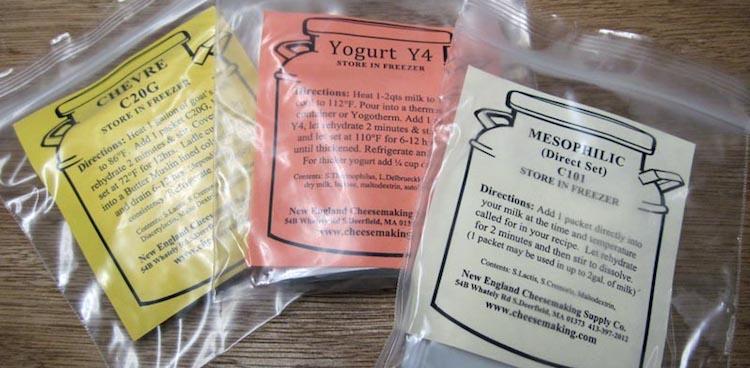
In my cheesemaking experience, I have been able to use both a homemade starter, commercial bulk starters, and commercial DVI. What are these I hear you ask?
In this post I will go back a step and define the differences and what a starter culture is. A starter is a collection of bacteria that begin a fermentation process. In this case they are lactic acid producing bacteria or lactobacillus. There are many ways of making a starter culture as you are harvesting and using bacteria that are naturally present in raw milk anyway. Commercially, the most common starter type now is called DVI (Direct Vat Inoculation) and it comes in the form of a freeze dried powder which can just be sprinkled into a vat in big creameries and therefore is pretty hassle free. Most small cheesemakers prefer to hydrate it in milk and freeze samples of this to add later as a thawed liquid because it is easier to control the quantity added and therefore the acidification that way when using smaller quantities of milk. These can range from quite simple starters with only a couple of strains of bacteria to more complex ones and are used not just in large mechanised creameries but also by smaller producers. The perceived wisdom is that they deliver more straight line flavours with less subtlety and complexity but the advantage is that they are fairly tried and tested. I know a number of small scale cheesemakers who have used them to deliver very characterful cheeses.
After that, we move on to bulk or pint starters. These are a liquid culture that sets to a yoghurt like consistency. It is frozen before use and added as a liquid to the vat. The theory goes that because the mixture is frozen as a liquid rather than as a powder, that less resilient but more flavour forming bacteria can be used and as a result they give more complex and interesting flavours. They are used at either creamery or larger farmhouse scale in the manufacture of cheeses such as Montgomery’s Cheddar, Keens Cheddar, Kirkham’s Lancashire, Colston Bassett Stilton and Stichelton or in very small scale one man cheesemaking such as St James. They are then cultured on by adding a set quantity of the original culture to sterilised milk, leaving it to adapt to the environment (but not start to grow and acidify) and then freezing again for use later. They need to be put in to freeze in what’s known as the lag phase, before they start reproducing, because once they start to reproduce they’re vulnerable and the freezing process can damage them. Before use they need around 20 hours to thaw and acidify and ideally should be a delicate set-yoghurt consistency.
Beyond that you move to the more artisan end of the starter spectrum, most commonly used in farmhouse manufacture and small scale at that: home made. The simplest starter occurs if you wait for your milk to sour naturally without adding anything at all. The difficulty with this is that it entirely depends on the quality of your raw milk. It can be prone to problems if the wrong sort of bacteria are present in your raw milk. At best this could mean yeast or coliform contamination (bubbles in the curd and a dirty flavour) or at worst full on pathogens (food poisoning). That said however, if your milking is beautifully clean, your herd in great health and your milk pretty consistent, it can give you great results.
Another less risky way of managing your own starter from your own raw milk, is to set some of it aside to sour up into a yoghurt like consistency and then mix this with milk you have sterilised into a series of pots and freeze these. The advantage of this is that you can pick your time to culture up the milk and choose a day when your testing shows the hygiene quality is particularly good.
I, personally, would also send off a sample for testing before you use it as well. You then have the advantage of using your own culture with your own milk’s natural lactobacillus and other flavour producing bacteria but without the worry that each day’s milk might be different or that today might be the day a problem occurs. Finally you can use whey from a previous make that has been left to acidify. This is a practice that I know from experience is quite often used in France and Italy and I surmise that it is used across the rest of Europe as well. It can be added in pots full or buckets full depending on your milk quantity. As a safeguard, you can freeze samples of the whey to return to every 6 months or so and you can also freeze a mixture of 1/3rd milk, 1/3rd whey, 1/3rd curd in case the frozen whey doesn’t work out. This is a bit like using your own soured milk in terms of the possibility for variability. It can give you great results if your milk is pretty consistent and your cheesemaking routine is consistent. I have had delicious cheeses made from whey starters from Mary Holbrook’s Tymsboro and fresh Mozzarella di Bufala to Cravero’s Parmigiano Reggiano 1470 so it suits all styles.
Photo Credit: Featured image by New england Cheesemaking Supply




What is the ratio of whey to gallon of raw milk to use as a starter?